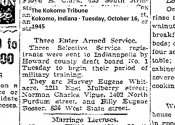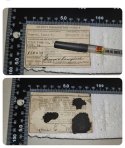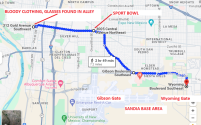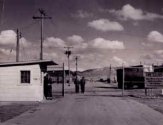crimeblogger1983
Former Member
- Joined
- Nov 22, 2016
- Messages
- 126
- Reaction score
- 165

Could this be him? The age kind of matches but heights a bit off https:///wiki/Peter_Turner
Can you link that? Thanks!
He was treasurer of a bowling league. They usually consisted of 8 teams of 4 people each team. 32 people divided by $400 = $12.50 per person. Below is a bowling alley in Nevada built in 1947 with the standard 8 lanes to accommodate 8 teams.Robbery looks like a strong motive at first, until you dig. I find it incomprehensible that the fees due for the bowling league was $400 in 1947! Was this the most expensive bowling alley in the world? None of those soldiers would've been able to afford such an expensive league. Its also crazy that he was wandering around with such a substantial sum. I believe this was a mistake or that whoever said he had that amount was lying about where it came from.
The 2761st Engineer Battalion (Special), which became a field unit under the Armed Forces Special Weapons Project (AFSWP) was taking over the nuclear bomb assembly function at Sandia Base. They were activated 19 August 1946. They were redesignated as the 38th Engineer Battalion (Special) on 1 May 1947.
The fabrication, assembly, and storage of nuclear weapons was also done at Sandia Base. The Operation CROSSROADS project, July 1, 1946 July 25, 1946, had ended Sept 1946.
By the end of June 1947, every officer and most of the enlisted men had participated in three or more assembly operations and a number of special projects.


It says the pass was for the night of July 1st. But Gene went missing on the evening of June 30th. Does this mean anything? Was he not supposed to be there that evening, or had he been working?The Kokomo Tribune, 17 Jul 1947, Thu ·Page 1, reports that Whitacre had a 24 hour leave to go into Albuquerque with a bowling team from the base on the night of July 1.
I was confused by this. What does it mean that it was found in the mail? Was it returned by someone else? and if so, why? Or is the pass issued elsewhere and posted to the base for Gene to collect? Is it significant that it was "delivered uncovered...with no posrage"?Albuquerque Journal 05 Jul 1947, Sat ·Page 1 "The Class A pass issued to Whitaker was found in mail delivered to the base. The pass was delivered uncovered, since the Sandia Base address was printed on the pass and bore no postage."
The Albuquerque Tribune 05 Jul 1947, Sat ·Pages 1- 4, "The return of the soldier's pass to Sandia Base by mail last Thursday."
It was the newspaper that stated he had a twenty-four hour pass for July 1. The Albuquerque Tribune 05 Jul 1947, Sat ·Page 1 states "Sgt. Whitacre has not been seen since he left Sandia Base on a pass last Monday night..." Farther up in the same article his name is spelled as Whitaker. (Sloppy reporting, I guess)It says the pass was for the night of July 1st. But Gene went missing on the evening of June 30th. Does this mean anything? Was he not supposed to be there that evening, or had he been working?
I was confused by this. What does it mean that it was found in the mail? Was it returned by someone else? and if so, why? Or is the pass issued elsewhere and posted to the base for Gene to collect? Is it significant that it was "delivered uncovered...with no posrage"?
I am sorry if this sounds dumb, but honestly I just have no idea!
Also, how common is it for soldiers to have second jobs? Especially ones who apparently have to be accounted for at all times?
Thank you very much for the information.Albuquerque Tribune 05 Jul 1947, Sat ·Page 1 & page 4 "Sgt. Whitacre has not been seen since he left Sandia Base on a pass last Monday night but two developments puzzled police...The developments were...The return of the soldier's pass to Sandia Base by mail last Thursday."
Albuquerque Journal 05 Jul 1947, Sat ·Page 1 "The Class A pass issued to Whitaker was found in mail delivered to the base. The pass was delivered uncovered, since the Sandia Base address was printed on the pass and bore no postage." "The Class A pass issued to Whitaker was found in mail delivered to the base. The pass was delivered uncovered, since the Sandia Base address was printed on the pass and bore no postage. An appeal was made for anyone who may have found the pass and mailed it in to notify base officials. Examination of the pass, enclosed in an isinglass (eisenglass) covering, failed to indicate where it was mailed from or by whom."
The pass was enclosed in clear vinyl sheeting would be an easier way to describe it. I would assume someone found it, thinking it was important, and put it in the mail. The news articles do not state (that I could find) when the pass was found in the base mail.
I don't know how common it was for military personnel to have second jobs.
In Whitacre's case, not only did he work at Sport Bowl, 3005 East Central Ave., Albuquerque but I found several news articles showing he was an accomplished bowler in tournaments at Sport Bowl earlier in June, 1947:
Albuquerque Journal 16 Jun 1947, Mon ·Page 5 "Vic Thiel beat Harvey Whitacre 998 to 959"
Albuquerque Journal 12 Jun 1947, Thu ·Page 4
The Albuquerque Tribune 09 Jun 1947, Mon ·Page 8
The Albuquerque Tribune 02 Jun 1947, Mon ·Page 8
We can pretty much assume that the Sport Bowl was the same bowling alley that he worked at and disappeared from on June 30, 1947. Of five bowling alleys named in Albuquerque newspapers over the years, only Sport Bowl was operating that night.
George Koval, who served in the Special Engineer force (like Whitacre) was only exposed as an important spy (at Oak Ridge) in recent years. He was a soldier, not a physicist,

Thank you.Also, in re: his 24-hour pass. This generally just permission to be off base. Even in the 90s, it wasn’t automatic that you could just wander into town or whatever. We also had to let our supervisor know where we were and how we could be contacted; for example, when I was in Monterey, CA, spending a weekend in San Francisco entailed filling out a form with the dates, address and phone number where we could be located. When we returned, we’d often get a debrief from OSI about anyone we’d been in contact with, no matter how seemingly casually.
We didn’t get paper passes, but here’s what they looked like in 1947:
If I made my map correctly, the alley behind 312 Gold Ave, which is between Gold Ave. and Silver Ave. is west of the Sport Bowl bowling alley at 3005 East Central Ave. The Sandia Base was south and east of the bowling alley. There were two security gates to the base; the Gibson Avenue Gate and the Wyoming Boulevard Gate.Thank you very much for the information.
Intriguing about the pass, I wish whoever mailed it had come forward so we'd know where it was found. It's another strange element but as you say, probably just someone trying to do the right thing.
So no one remembers him leaving the bowling alley at all. That means he didn't say goodbye to anyone I guess.
What do you make of the potentially staged clothing in the alley?


That's insane, because I wrongly assumed the alley was right behind the bowling alley! My mistake totally. I cannot begin to imagine what he was doing in this location. The idea that they were tossed from a car makes alot of sense. I wonder what happened to his trousers and shoes? It almost sounds like someone had removed his upper body clothing, tossed them, and then drove on with a half naked Gene?If I made my map correctly, the alley behind 312 Gold Ave, which is between Gold Ave. and Silver Ave. is west of the Sport Bowl bowling alley at 3005 East Central Ave. The Sandia Base was south and east of the bowling alley. There were two security gates to the base; the Gibson Avenue Gate and the Wyoming Boulevard Gate.
If Whitacre left the bowling alley that night to head back to the base (no one saw him leave), he was going in the wrong direction fi we are to believe he ended up in that alley. I, too, believe those items were staged in the alley. Or tossed. I'm guessing they were thrown out of a vehicle. It's a 44 minute, 2 mile walk from Gold Ave to the bowling alley, or eight minutes in a vehicle.
I wonder if the items in the alley were tested for DNA to see if anyone else's DNA was on them other than Whitacre's.
View attachment 488020
Sandia Base public domain photo from Wikipedia.
View attachment 488023
am I right to assume that this would need to be kept on your person at all times while off the base?
Therefore if we knew where it had been found, we'd have an idea where Gene had been/gone?
Koval, although a private, is rather a special case. He trained as a chemical engineer in the USSR, then as an electrical engineer in the US.
I also don’t think Whitacre was killed/abducted for any secrets.
There are two reasons:
1) I was in the USAF in the ‘90s, and my MOS required a Top Secret/SCI clearance. This doesn’t mean you have access to everything classified as such; generally only what you have a need to know (for your specific job.)
But more importantly, 2) Klaus Fuchs had already given everything we knew about the atomic bomb to the Soviets in 1945:
“Klaus Fuchs, a German-born physicist who had helped the United States build its first atomic bombs, was arrested for passing nuclear secrets to the Soviets. While stationed at U.S. atomic development headquarters during World War II, Fuchs had given the Soviets precise information about the U.S. atomic program, including a blueprint of the “Fat Man” atomic bomb later dropped on Japan, and everything the Los Alamos scientists knew about the hypothesized hydrogen bomb.” (Ref)
So certainly, a low-level enlisted person (as Whitacre, and I was) can have access to TS information, but it isn’t generally worth killing them over, IMO.
The simplest explanation is that someone (lots of people, by the sound of it) knew he was carrying around a lot of cash, and the usual thing occurred.
Also, in re: his 24-hour pass. This generally just permission to be off base. Even in the 90s, it wasn’t automatic that you could just wander into town or whatever. We also had to let our supervisor know where we were and how we could be contacted; for example, when I was in Monterey, CA, spending a weekend in San Francisco entailed filling out a form with the dates, address and phone number where we could be located. When we returned, we’d often get a debrief from OSI about anyone we’d been in contact with, no matter how seemingly casually.
We didn’t get paper passes, but here’s what they looked like in 1947:
...I was stationed at Ft Lost-In-The-Woods, Bragg and Ft. Gordon and even in Stuttgart, Germany. I never saw a pass my whole time in and never had to use one. My MOS was 95B
